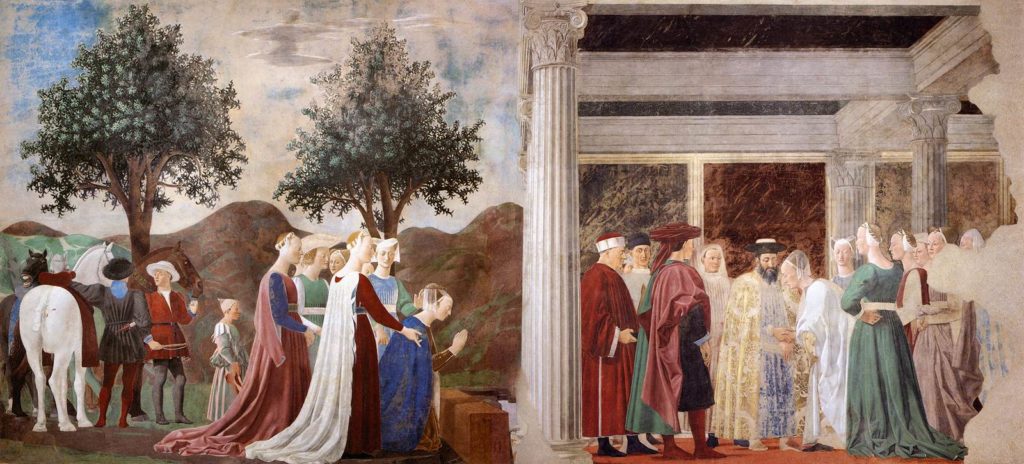“The Queen of Sheba in Adoration of the Wood of the Cross and the Meeting of King Solomon and the Queen of Sheba” from “The Legend of the True Cross”, Piero della Francesca, Church of San Francesco, Arezzo, Italy. This fresco is directly beneath the scenes of the death of Adam, which were looked at in Part I. Like the scene above, the register is divided into two distinct sections. Notice both the symmetry and the contrast between the world of the first Adam and the courtly life of Solomon. Standing at the entrance to the chapel, your eyes would move down from the fresco above and you would see the right hand group first, that is, the meeting of Solomon and the Queen, and the left hand scene which shows the Queen of Sheba adoring the wood from which the cross will be made. Once inside the chapel, the left hand scene is more visible and the eye moves from left to right, so that in viewing these frescos in the chapel, your eyes would actually trace the sign of the cross. Sheba was a kingdom in the Southern Arabian Peninsula. The Queen of Sheba heard of Solomon’s wisdom and came “to test him with hard questions” (1 Kings 10:1ff). This sounds rather adversarial, but she was completely won over, when she heard his wisdom and saw the splendid palace which he had built along with his servants and courtiers. Now for the left hand section of this fresco, Piero della Francesca draws on an embellished version of 1 Kings 10 which is found in Jacopo da Voragine’s Golden Legend. In fact, Voragine gives a number of variants, but Piero seems to following the one in which the angel had given Seth a twig from the tree for which Adam sinned, with the promise that when this tree bore fruit, his father would be healed and made well. But when Seth returns and finds that his father has already died, he plants the twig over the grave. It becomes a great tree, which lasts until the time of Solomon. Solomon had the tree cut down to be used in his palace. However, the piece of wood it yielded was either too big or too small for the existing structure. It was discarded to be used as a footbridge over a pond. When the Queen of Sheba came to this bridge she would not cross it. She stopped and knelt before it. In the Golden Legend she returns home and sends Solomon a prophetic message saying that a man would hang upon this wood and by that man’s death the Kingdom of the Jews would be destroyed. Solomon had the wood taken and buried deep beneath the ground. Piero includes a scene on the back wall where the wood is being carried away to be buried. On the right hand side, we have the meeting of the two monarchs in an open portico with splendid renaissance columns and showing clear lines of perspective, as disseminated by the work of Piero’s contemporary Leon Battista Alberti. 1 Kings 7.1ff says that it took Solomon 13 years to build his palace. It gives details for a part of it, called “The House of the Forest of Lebanon”. This probably the location which Piero depicts in the right hand side of the fresco. The central column divides the two scenes. In both, the Queen is back by an semi-circle of ladies in waiting, arranged almost like and apse. Their high foreheads and long necks conform to contemporary ideas of female beauty. Their clothes reflect contemporary fashion. Piero achieves a sense of depth by setting different colours against each other placing the figures in different plains. There is a sense of balance and harmony. The white horse, perfectly foreshortened matches the white cloak of an attendant. The two trees act as a canopy above the group, emphasising the dignity of the Queen and her retinue. The arrangement is reversed under the portico but again the same sense of harmony and dignity is achieved. The eyes moves horizontally from arm to arm and robe to robe. It like a procession frozen in time. All of these effects are enhanced by the low vantage point of the viewer. But looking upwards, The Queen, the plank and the column are seen beneath Seth, the twig being planted and the great tree. Standing outside the chapel, the central column would be seen to divide the fresco into two distinct scenes in a harmonious and balanced way. But viewed from inside, the plank of wood breaks the harmony. It is now oddly spaced in relation to the column and so what we see are two distinct scenes. The left hand scene is like a truncated nativity scene. In the place of the mother and child we find the wood of the cross. The two scenes now bear no spatial relationship. Thus the central focus becomes this rejected plank of wood. In this way, the prominence of the column yields to the significance of the plank of wood, which became a bridge, and then a cross. Tomorrow in the Liturgy, we begin Passiontide. We will drape the cross in purple, not to obscure it, but rather to emphasise its true significance.


The Catholic Chaplaincy serves the students and staff of the University of Edinburgh, Edinburgh Napier University and Queen Margaret University.
The Catholic Chaplaincy is also a parish of the Archdiocese of St Andrews and Edinburgh (the Parish of St Albert the Great) and all Catholic students and staff are automatically members of this parish.